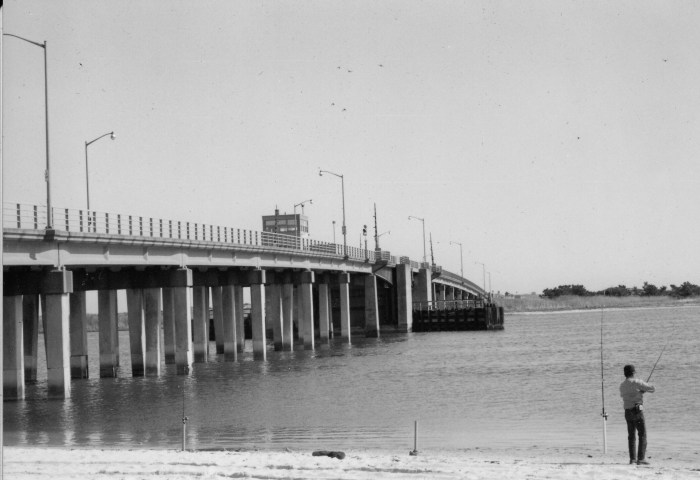
The Smith Point Bridge Replacement Project has received a boost of $5 million to its appropriated federal funding with the passage of the Consolidated Appropriations Act, 2024, back in March. The funds came in the form of a congressional earmark requested by Representative Andrew Garbarino (R) and Senator Chuck Schumer (D).
Smith Point Bridge is one of only two road connections between Fire Island and the mainland. Specifically, the bridge allows motorists riding on the William Floyd Parkway to reach Smith Point County Park and Fire Island’s east end. The current Smith Point Bridge needs replacement because it has reached beyond the end of its planned lifespan according to past statements by Suffolk County Department of Public Works officials.
Representative Garbarino submitted a letter requesting funding for the project to the chair of the House Appropriations Committee on March 31, 2023. Senator Schumer is also listed as a requestor for this $5 million earmark by House Appropriations Committee documents.
Representative Garbarino’s office responded to a Fire Island & Great South Bay News inquiry about the earmark by issuing the following statement: “This funding for the Smith Point Bridge Replacement Project will be used to complete the project at William Floyd Parkway over Narrow Bay in the Town of Brookhaven. With these federal funds, we aim to eliminate structural deficiencies of the poorly rated existing bridge and replace it in order to improve safety, ADA access, mobility, and operations for motorists, pedestrians, and bicyclists.”
Neither Senator Schumer’s office nor the Suffolk County executive’s press office responded to Fire Island & Great South Bay News inquiries on this topic in time to be quoted for this story.
Former Suffolk County Department of Public Works Commissioner Joseph Brown told Newsday in January of 2023 that the new bridge will have “at least a 55-foot clearance over mean high water,” “a 12-foot shared use path” for cyclists and pedestrians, and two car travel lanes with four-foot shoulders on either side of those lanes. The current bridge is an unruly and outdated drawbridge with much lower clearance that does not include a pedestrian path. Newsday also quoted Suffolk County Legislator James Mazzarella (R) as saying that the replacement project will also create a new fishing pier and an observation area on the new bridge.
While the total cost of the Smith Point Bridge Replacement project was estimated at just $84,949,000 in June of 2022 that number has risen to $126,659,000 as of October 2023 according to Suffolk County Budget resolutions. Brown told Newsday the project was facing rising costs because of rising construction costs nationally and the addition of the shared-use pedestrian path that had not been included in previous iterations of the plan. The 2023 budget resolution (Resolution No. 822-2023) breaks this number down into $8,249,000 for planning and design and $118,410,000 for construction.
Resolution No. 822-2023 also states that 80% of the funds will come from various federal programs including the Bridge Formula Program (BFP), the Surface Transportation Block Grant (STBG), and the National Highway Performance Program (NHPP), while 20% will be covered by Suffolk County. It is unclear how or if the latest congressional earmark will change these calculations or if the project or its costs have changed since 2023. It should also be noted that Suffolk County approved the issuance of $23,682,000 in county bonds in October 2023 to finance a portion of the project’s cost with Bond Resolution No. 821-2023.
The current process to replace the Smith Point Bridge is just the latest episode in the long and bizarre history of the bridge that Fire Island & Great South Bay News has explored in the past. The original iteration of the Smith Point Bridge was built by an Irish immigrant named Michael Gillespie in 1916 at the behest of eccentric businessman Fredrick J. Quimby who wanted to attract rich investors to his beachfront development on the other side of the water. While Quimby had originally pictured a grand drawbridge large enough for all but the largest vessels to pass underneath, he only raised enough money to create a humble wooden footbridge, though it still featured an engine-driven drawbridge component.
Quimby’s bridge did not last long. In 1917 the middle of the bridge was destroyed by an ice jam, setting a pattern in which the wooden foot bridge was rebuilt and destroyed several times until the last one was destroyed in 1927 — though not before a caravan of camels and horses being used for the film “The Son of the Sheik” crossed the bridge in 1926. The current steel and concrete drawbridge opened on July 4, 1959, at a cost of $2.5 million after four years of construction. The current bridge has been serving the people of Suffolk County for around 65 years. According to Brown, it was only expected to last 40 years at the time of its construction. Discussions about replacing the bridge have been underway since at least 2016 according to various county documents.
The bridge is still considered safe by the New York Department of Transportation but the department rated the bridge’s condition as poor after its last inspection in 2022. A bridge receiving a rating of “poor” does not mean that the bridge is in imminent danger of collapse. However, a bridge with this rating may require weight limit postings, more frequent monitoring, more maintenance, more repairs, or replacement. Suffolk County has opted for the long-term solution of replacing this decades-old piece of infrastructure. Brown estimates that construction will begin in late 2024 and last about three years. He also said that the existing bridge will continue to operate while its replacement is being built, making Fire Island’s east end accessible throughout the span of the project.



























